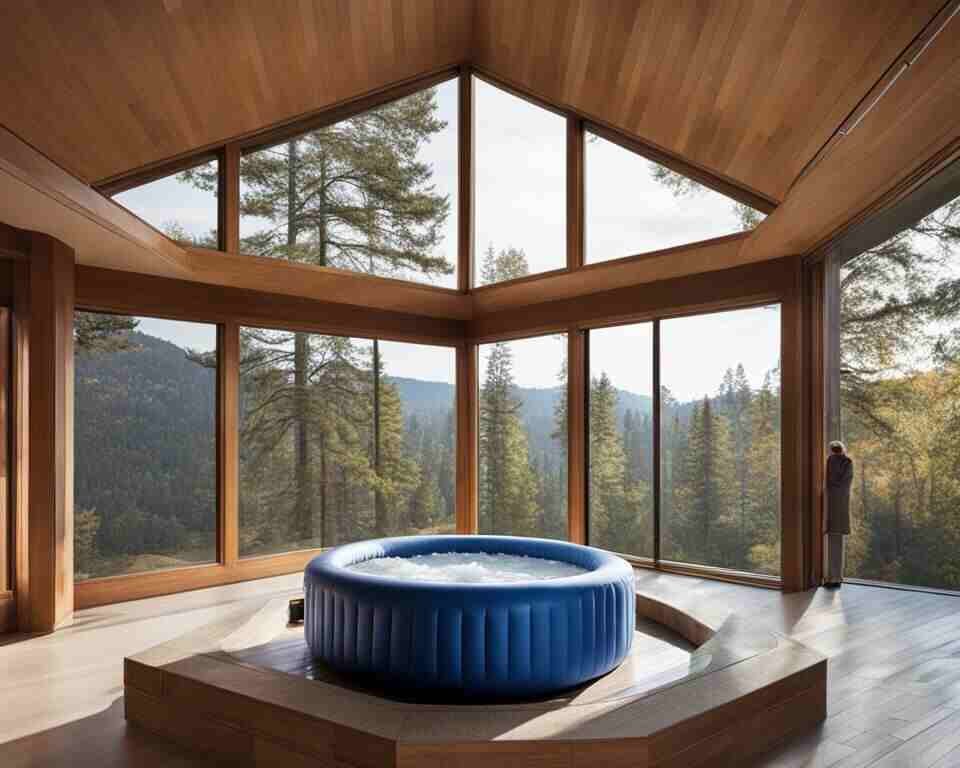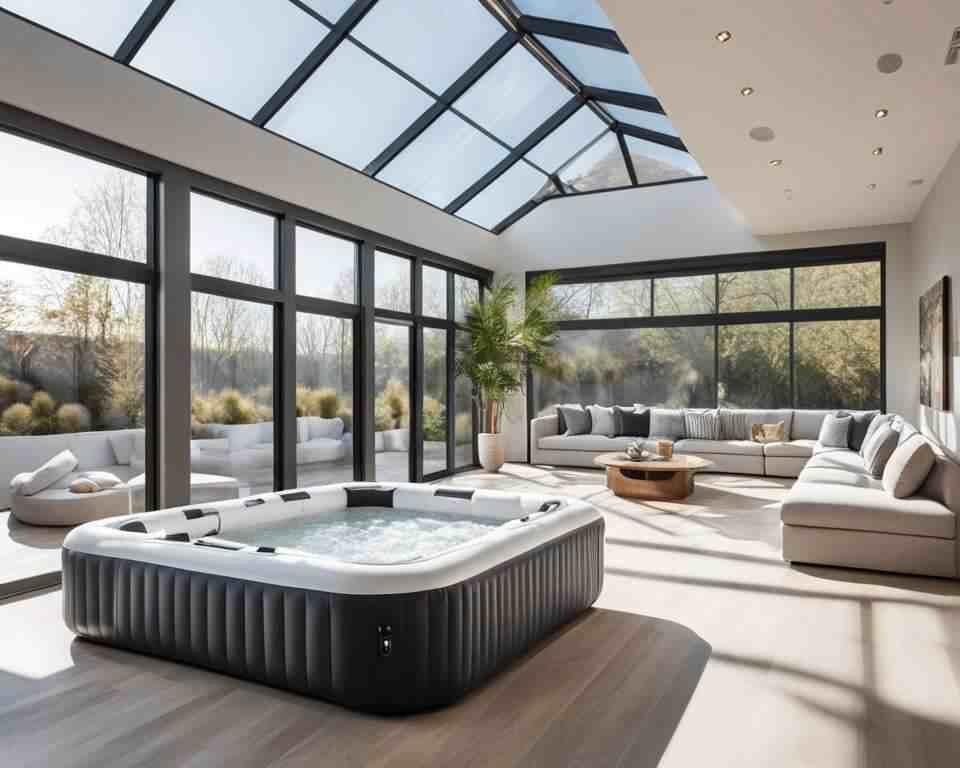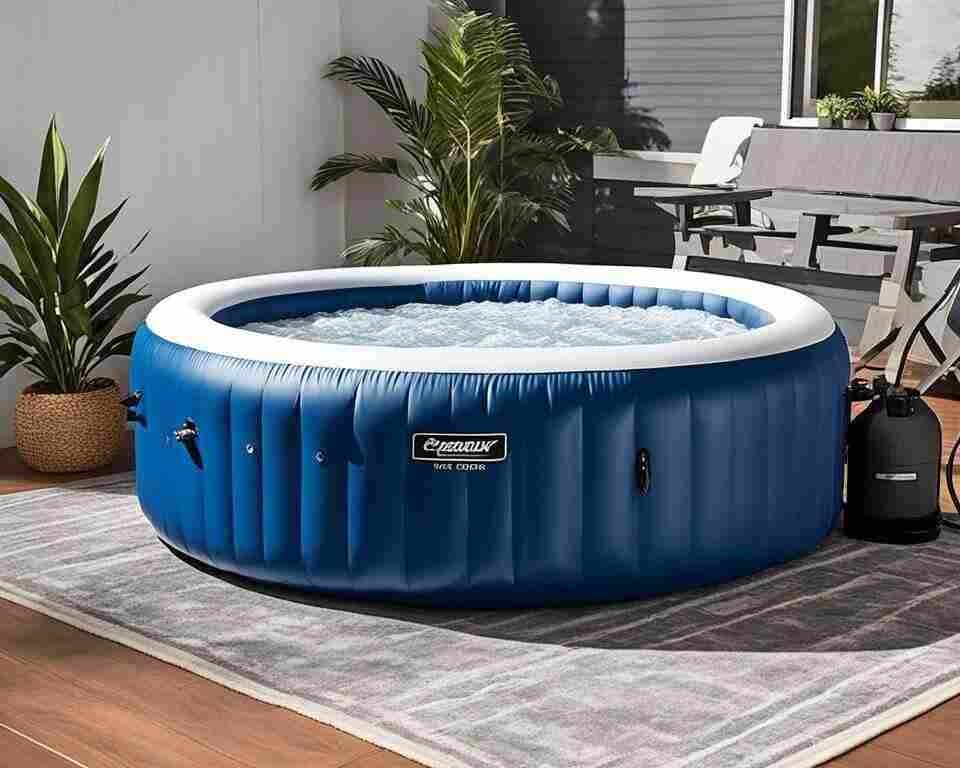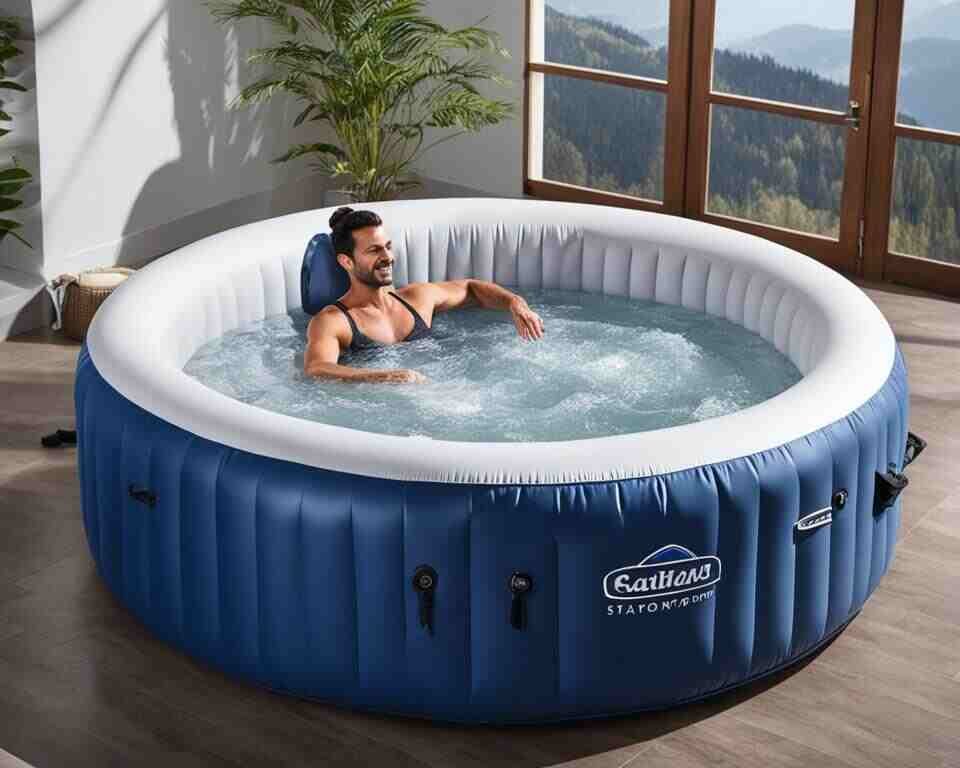Welcome to my article where we answer the question: Can Inflatable Hot Tubs Be Used Indoors? Many people wonder about bringing the relaxation and luxury of a hot tub inside their homes.
In this article, we explore the possibilities and discuss the benefits, guidelines, and considerations for using inflatable hot tubs indoors. So, let’s dive in!
Key Takeaways:
- Indoor use of inflatable hot tubs is indeed possible and offers various benefits.
- Using an inflatable hot tub indoors allows for privacy, convenience, and a sheltered environment.
- Proper ventilation, space requirements, and flooring considerations are important for indoor installations.
- Guidelines for using inflatable hot tubs indoors ensure safety and optimal performance.
- Selecting the right inflatable hot tub and maintaining it properly are key for indoor use.

Indoor vs. Outdoor Inflatable Hot Tub Installation
When it comes to installing an inflatable hot tub, one of the key decisions you’ll need to make is whether to set it up indoors or outdoors. Both options have their advantages and considerations that need to be taken into account. In this section, we will compare and contrast the installation process for indoor and outdoor inflatable hot tubs, highlighting the differences in space requirements, flooring and foundation concerns, and ventilation and humidity control.
Let’s start by discussing the space requirements. Indoor installations typically require a dedicated room, such as a basement or spare room, with enough space to accommodate the hot tub and allow for easy access. On the other hand, outdoor installations can be set up in various locations, such as a backyard patio or deck, without the need for a specific room or additional space considerations.
Another important factor to consider is the flooring and foundation. For indoor installations, it’s crucial to ensure that the flooring can support the weight of the hot tub when filled with water. Additionally, proper insulation and protection against water damage are essential to prevent any potential issues. Outdoor installations, on the other hand, may require a level foundation or a suitable base, such as a concrete pad or reinforced deck, to provide stability and durability.
Lastly, ventilation and humidity control are vital considerations for indoor installations. Proper ventilation helps to remove excess heat and moisture from the hot tub’s environment, ensuring a comfortable and safe experience. Humidity control measures, such as dehumidifiers or adequate airflow, help to prevent mold and mildew growth. Outdoor installations, on the other hand, benefit from natural ventilation and don’t typically require additional measures for humidity control.
By carefully considering these factors, you can make an informed decision about whether to install your inflatable hot tub indoors or outdoors. Whether you choose the convenience and privacy of an indoor installation or the open-air experience of an outdoor setup, ensuring proper space, flooring, ventilation, and humidity control measures will help you create the perfect hot tub oasis.
Considerations for Using Inflatable Hot Tubs Indoors
Space Requirements and Accessibility
When considering using inflatable hot tubs indoors, it is important to assess the space available in your home. These tubs come in a variety of sizes, so you need to ensure that you have enough room for not only the tub itself but also for easy access and movement around it. Measure the designated area to determine if it can accommodate the dimensions of the hot tub you have in mind.

Flooring and Foundation Concerns
The type of flooring and foundation in the room where you plan to install your inflatable hot tub should also be taken into consideration. It is essential to choose a location with a sturdy floor that can support the weight of the filled tub. Carpeted areas or floors that are susceptible to damage from moisture may not be suitable. Additionally, you may want to use a non-slip mat or a protective layer to prevent any potential damage to the flooring from the hot tub.
Ventilation and Humidity Control
Proper ventilation and humidity control are crucial when using an inflatable hot tub indoors. The heat and steam generated by the tub can create a humid environment, which may lead to condensation and moisture buildup. This can potentially cause damage to the surrounding walls or furniture. Ensure there is adequate airflow in the room, either through natural ventilation or by using mechanical ventilation systems like fans or dehumidifiers.
| Considerations for Using Inflatable Hot Tubs Indoors | Space Requirements and Accessibility | Flooring and Foundation Concerns | Ventilation and Humidity Control |
|---|---|---|---|
| Determine if the available space can accommodate the tub’s dimensions | Choose a location with a sturdy floor and consider using a non-slip mat | Ensure proper ventilation to prevent moisture damage | Use fans or dehumidifiers to control humidity levels indoors |
Understanding the Benefits of Indoor Inflatable Hot Tubs
In this section, we will explore the various benefits of using inflatable hot tubs indoors. Indoor hot tubs provide a range of advantages, including privacy, convenience, and shelter, as well as the ability to create a relaxing and secluded environment.
Privacy: One of the significant benefits of using inflatable hot tubs indoors is the increased privacy it offers. Unlike outdoor hot tubs, indoor setups provide a more intimate and secluded space where you can enjoy your soak without worrying about prying eyes or nosy neighbors.
Convenience: Having an inflatable hot tub indoors allows for easy access and convenient use. Regardless of the weather conditions outside, you can enjoy a soothing soak whenever you desire. It eliminates the hassle of preparing yourself to venture outdoors or bundling up in cold weather, making your hot tub experience more enjoyable and accessible.
Shelter: Indoor hot tubs provide protection from external elements such as rain, wind, or extreme temperatures. This makes them suitable for year-round use, regardless of seasonal changes. You can relax in your hot tub without worrying about the weather outside, ensuring a hassle-free and enjoyable experience.
Creating a Relaxing Environment: Inflatable hot tubs placed indoors can help create a serene and calming atmosphere. You have the freedom to set up your hot tub in a space designed for relaxation, such as a dedicated spa room or a cozy corner in your home. You can enhance the ambiance with soft lighting, soothing music, and aromatic scents, transforming your hot tub experience into a mini retreat.
Overall, using inflatable hot tubs indoors offers a range of benefits, including enhanced privacy, convenience, shelter, and the ability to create a tranquil environment. Whether you prefer a solo soak or plan to enjoy it with loved ones, bringing the hot tub indoors provides a luxurious and enjoyable retreat within the comfort of your home.
Setting Up Your Indoor Inflatable Hot Tub
Choosing the Right Location
When setting up an indoor inflatable hot tub, choosing the right location is crucial for ensuring a safe and enjoyable experience. Here are some key considerations to keep in mind:
- Accessibility: Select a location that provides easy access to the hot tub. Ideally, it should be in an area where you can easily step in and out of the tub without any obstructions.
- Solid Flooring: Place the hot tub on a level and sturdy surface. Avoid carpeted areas or spaces with weak flooring. A concrete or tiled floor is generally recommended.
- Proximity to Water Source: Position the hot tub near a water source for easy filling and draining.
- Privacy: If possible, choose a location that offers privacy. This will allow you to fully relax and enjoy your hot tub experience without feeling exposed.
Consider these factors when selecting the right location for your indoor hot tub, taking into account your personal preferences and the layout of your home.
Installation Guide: From Unboxing to Enjoyment
Once you have chosen the perfect location, it’s time to set up your indoor inflatable hot tub. Follow this step-by-step installation guide:
- Unbox the Hot Tub: Carefully unpack the hot tub and ensure all parts are included.
- Prepare the Space: Clean the designated area and make sure it is free from debris and dust.
- Inflate the Hot Tub: Using an air pump or the provided inflation system, inflate the hot tub until it reaches its recommended size and shape.
- Connect the Control Panel: Attach the control panel to the hot tub and ensure all connections are secure.
- Fill the Hot Tub: Connect a hose to a water source and fill the hot tub with the desired amount of water. Ensure the water level is within the recommended range.
- Install Filtration System: Set up the filtration system according to the manufacturer’s instructions. This will help keep the water clean and clear.
- Set the Temperature: Adjust the temperature settings on the control panel to your desired level.
- Add Chemicals: Follow the manufacturer’s guidelines for adding the appropriate chemicals to maintain water hygiene.
- Enjoy Your Hot Tub: Once the water is heated to your desired temperature, carefully enter the hot tub and experience ultimate relaxation.

Follow these installation steps to ensure that your indoor inflatable hot tub is set up properly and ready for you to enjoy.
Mitigating the Challenges of Indoor Use
When using inflatable hot tubs indoors, there are several challenges that need to be addressed to ensure a safe and enjoyable experience. Two key factors to consider are proper ventilation strategies and waterproofing your indoor environment.
Proper Ventilation Strategies
Ventilation is crucial when using hot tubs indoors as it helps maintain a comfortable and healthy environment. Adequate ventilation helps remove excess humidity, prevent the buildup of mold and mildew, and improve air quality. To achieve proper ventilation, you can:
- Install windows that can be opened to allow fresh air to circulate.
- Use exhaust fans or a ventilation system to remove humid air from the hot tub area.
- Consider installing a dehumidifier to control moisture levels in the indoor space.
By implementing these ventilation strategies, you can mitigate the challenges associated with indoor hot tub use and create a more comfortable environment.
Waterproofing and Protecting Your Indoor Environment
Waterproofing is essential to prevent water damage and protect your indoor environment from potential leaks and spills. Here are some steps you can take to waterproof your indoor hot tub area:
- Ensure that the flooring is sealed and waterproofed.
- Use a durable and water-resistant material, such as ceramic tiles or vinyl, for the hot tub surroundings.
- Consider installing a waterproof membrane beneath the hot tub to provide an extra layer of protection.
- Regularly inspect the hot tub for any signs of leaks or damage and address them promptly.
By taking the necessary precautions to waterproof your indoor environment, you can enjoy your hot tub without worrying about damaging your flooring or creating moisture-related issues.
Can Inflatable Hot Tubs Be Used Indoors: Evaluating Safety and Practicality
When considering the use of inflatable hot tubs indoors, it’s essential to evaluate both the safety and practicality aspects. By examining the necessary safety considerations and assessing the practicality in terms of accessibility and convenience, you can make an informed decision regarding indoor use.
First and foremost, safety should be a top priority when using an inflatable hot tub indoors. It’s crucial to ensure that the electrical requirements are met, and the hot tub is properly grounded to prevent any electrical hazards. Additionally, adequate water drainage is essential to avoid any potential flooding or water damage.
Regarding practicality, indoor use offers certain advantages in terms of accessibility and convenience. Having an inflatable hot tub indoors allows for easy access regardless of weather conditions, ensuring year-round enjoyment. It also provides privacy and comfort, allowing you to relax and unwind in the convenience of your own home.
To further enhance the safety and practicality of using an inflatable hot tub indoors, proper ventilation should be considered. Adequate ventilation helps control humidity and prevents the buildup of moisture, reducing the risk of mold or mildew growth.
Overall, using inflatable hot tubs indoors can be both safe and practical, provided that the necessary safety precautions are taken and ventilation is properly maintained. By carefully evaluating these factors, you can create a relaxing and enjoyable indoor hot tub experience.
Selecting the Best Inflatable Hot Tubs for Indoor Use
When it comes to choosing the best inflatable hot tub for indoor use, there are a few key features to look out for. These features will help ensure that your hot tub not only fits well in your indoor space but also provides optimal comfort and convenience. Here, I will discuss the important features to consider when selecting an indoor-friendly model and provide recommendations for the top inflatable hot tubs suitable for indoor spaces.
Features to Look for in Indoor-Friendly Models
1. Size and Dimensions: The size of the inflatable hot tub should be suitable for your indoor space. Measure the available area carefully and choose a model that fits comfortably without overcrowding the room.
2. Weight: Since you’ll be setting up the hot tub indoors, it’s essential to consider the weight. Look for a model that is lightweight and portable, making it easier to move and install in your desired location.
3. Noise Level: Indoor hot tubs should operate quietly to prevent any disturbance, especially if your indoor space is close to bedrooms, living areas, or shared spaces. Opt for a hot tub that has effective noise reduction features.
4. Temperature Control: Ensure that the hot tub comes with accurate temperature control features, allowing you to adjust and maintain the water temperature according to your preference.
5. Durability and Material: Look for a hot tub made from durable, puncture-resistant materials that can withstand repeated use indoors. Nylon and PVC are popular choices for indoor-friendly inflatable hot tubs.
Top Recommended Inflatable Hot Tubs for Indoor Spaces
| Brand | Model | Capacity (Number of People) | Dimensions (Inflated) | Features |
|---|---|---|---|---|
| Intex | PureSpa Plus | 4 | 77 x 28 inches | Adjustable jets, built-in hard water treatment system |
| Coleman | SaluSpa | 6 | 77 x 28 inches | Remote-controlled pump, rapid heating system |
| Bestway | Lay-Z-Spa Miami | 2-4 | 71 x 26 inches | Digital control panel, massage system |
These recommended inflatable hot tubs not only meet the criteria for indoor use but also offer a range of features that enhance the overall hot tub experience. With options suitable for different capacities and budgets, you can find the perfect indoor-friendly model for your needs.
Before making a final decision, it’s important to consider your specific requirements and preferences. Additionally, always refer to the manufacturer’s guidelines and recommendations to ensure the safe and proper use of the hot tub in an indoor setting.
Maintenance and Upkeep of Indoor Inflatable Hot Tubs
Proper maintenance is crucial for ensuring the longevity and optimal performance of indoor inflatable hot tubs. In this section, we will discuss the essential aspects of maintaining and caring for your indoor hot tub. We will cover cleaning and chemical treatment, as well as drainage solutions specifically designed for indoor settings.
Cleaning and Chemical Treatment
To keep your indoor inflatable hot tub clean and hygienic, regular cleaning is necessary. This involves removing debris, sanitizing the tub, and maintaining proper chemical balance. Here are some important steps to follow:
- Remove debris: Use a skimmer net or vacuum to remove any leaves, insects, or other debris that may have entered the tub.
- Drain and clean: Periodically drain the water from the hot tub and thoroughly clean the surface using mild soap or a specially formulated hot tub cleaner. Rinse thoroughly to remove any residue.
- Chemical treatment: Test the water regularly and adjust the chemical levels as needed. This includes maintaining the appropriate pH balance, sanitizer levels, and alkalinity. Follow the manufacturer’s instructions and use recommended hot tub chemicals.
- Filter maintenance: Clean or replace the hot tub filter regularly to ensure optimal filtration and water quality. A dirty or clogged filter can hinder the efficiency of your hot tub.
By following these cleaning and chemical treatment practices, you can ensure a clean and safe environment for enjoying your indoor inflatable hot tub.
Drainage Solutions for Indoor Settings
Draining your indoor inflatable hot tub can be a challenge due to the lack of natural drainage options. However, there are effective solutions available to overcome this issue:
- Drainage pumps: Invest in a reliable drainage pump designed for hot tubs. These pumps make it easy to empty the water from your indoor hot tub and direct it to a suitable drainage point.
- Plumbing connections: Install a dedicated drainage system that connects your hot tub to the existing plumbing in your home. This allows for seamless and efficient drainage without the need for external pumps.
- Gravity drainage: If possible, position your indoor hot tub in an area where gravity can assist with drainage. This may require planning the layout of your indoor space and considering the slope of the floor to ensure proper water flow.
By implementing suitable drainage solutions for your indoor hot tub, you can easily and effectively manage the process of emptying and refilling the water as needed.

| Challenges | Solutions |
|---|---|
| Lack of natural drainage options | Invest in a drainage pump or install a dedicated plumbing connection |
| Maintaining cleanliness and hygiene | Regular cleaning, chemical treatment, and filter maintenance |
Conclusion
In conclusion, the use of inflatable hot tubs indoors can be a viable option for those seeking relaxation and hydrotherapy benefits in the comfort of their own homes. Throughout this article, we have explored the considerations, benefits, and safety aspects of using inflatable hot tubs indoors.
When considering indoor use, it is important to take into account factors such as space requirements, flooring and foundation concerns, and proper ventilation and humidity control. By addressing these considerations, you can create a safe and enjoyable environment for your indoor hot tub.
The benefits of using inflatable hot tubs indoors are numerous. Indoor hot tubs offer privacy, convenience, and shelter from the elements, allowing you to enjoy a relaxing soak regardless of the weather. Additionally, indoor hot tubs can create a secluded and tranquil atmosphere, enhancing your overall hydrotherapy experience.
Before using an inflatable hot tub indoors, it is crucial to ensure that you follow the guidelines for installation and maintenance. Proper cleaning, chemical treatment, and drainage solutions designed for indoor settings will help keep your indoor hot tub in optimal condition.
Ultimately, the decision to use an inflatable hot tub indoors depends on your specific needs and circumstances. By considering the information provided in this article, you can determine whether or not using an inflatable hot tub indoors is a suitable option for you.

